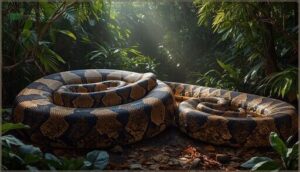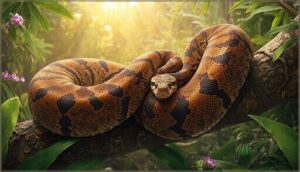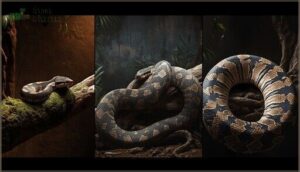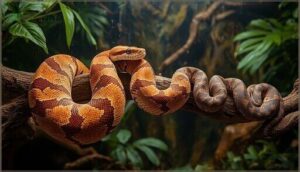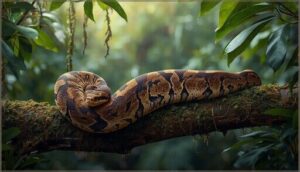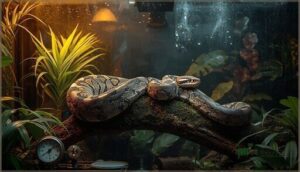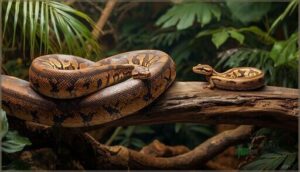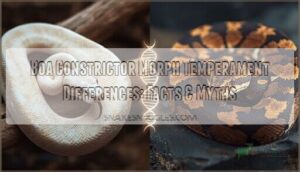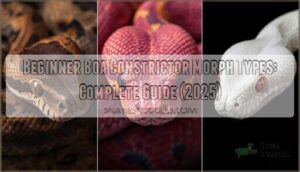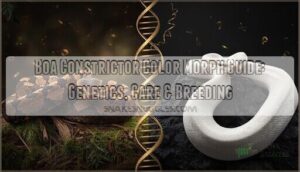This site is supported by our readers. We may earn a commission, at no cost to you, if you purchase through links.
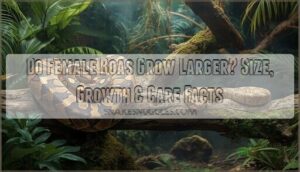 You’ve probably spotted the pattern at your local reptile show—those impressive boas stretching past 8 feet? Nearly all of them are female. Female boas grow larger than males by a significant margin, with mature females generally reaching 14% greater length and a striking 51% more body mass than their male counterparts. This isn’t just coincidence—it’s sexual size dimorphism hardwired into their biology.
You’ve probably spotted the pattern at your local reptile show—those impressive boas stretching past 8 feet? Nearly all of them are female. Female boas grow larger than males by a significant margin, with mature females generally reaching 14% greater length and a striking 51% more body mass than their male counterparts. This isn’t just coincidence—it’s sexual size dimorphism hardwired into their biology.
Reproduction drives everything in the boa world, and carrying up to 65 live young demands a body built for the job. Understanding these size differences matters whether you’re selecting your first boa or planning breeding projects, because that adorable 18-inch juvenile will grow into vastly different adult sizes depending on its sex.
Table Of Contents
- Key Takeaways
- Do Female Boas Grow Larger Than Males
- Growth Patterns in Boa Constrictors
- Factors Affecting Boa Size
- Female Boa Size and Reproductive Biology
- Boa Constrictor Care for Optimal Growth
- Size Variations Among Boa Species
- Top 5 Feather Boa Products for Snake Lovers
- Frequently Asked Questions (FAQs)
- Conclusion
Key Takeaways
- Female boa constrictors consistently outsize males by 14% in length and 51% in body mass—a size difference driven by the biological demands of carrying litters ranging from 10 to 65 live young.
- Growth patterns differ dramatically between life stages, with juveniles adding 30–45 cm annually during their first three years before slowing to under 10 cm per year once they reach sexual maturity.
- Your boa’s final size depends on three interconnected factors: genetic lineage (including subspecies and geographic origin), feeding quality and frequency, and environmental conditions like temperature gradients and habitat space.
- Larger female boas achieve significantly higher reproductive success, with maternal body length accounting for 52% of litter size variation and producing more viable offspring throughout their 20–30 year lifespan.
Do Female Boas Grow Larger Than Males
Yes, female boas grow noticeably larger than their male counterparts—it’s one of the clearest examples of sexual size dimorphism you’ll find in snakes. This size difference isn’t random; it’s driven by reproductive biology and has been documented across countless field observations and captive breeding programs.
Let’s break down exactly how much bigger females get, what the average measurements look like, and why nature designed them this way.
Sexual Size Dimorphism in Boa Constrictors
Why do female boas outsize their male counterparts so dramatically? Sexual dimorphism in Boa constrictors shows females are 14% longer and 51% heavier than males—a striking size difference driven by reproductive strategies and maternal investment.
Female boa constrictors are 14% longer and 51% heavier than males—a striking size difference driven by reproductive demands
This SSD index reflects anatomical differences shaped by genetic lineages, where Boa constrictor growth patterns favor larger females. Boas are powerful constrictors, using this method to subdue their prey.
You’ll find this dimorphism consistent across wild and invasive populations alike.
Average Female Vs. Male Boa Lengths
When you compare mature boas, the sexual dimorphism becomes crystal clear. Female boas generally stretch 7–10 feet, while male boas average 6–8 feet—a size difference you’ll notice immediately. Here’s what field data shows:
- Females commonly reach 2.1–3.0 meters in length
- Males generally range 1.8–2.4 meters at maturity
- Captive females often exceed 10 feet with proper care
- Over 75% of boas surpassing 3 meters are female
- Captive vs. wild populations show 10–20% length variations
That size discrepancy persists across all populations.
Biological Reasons for Female Size Advantage
Why do female boas outpace males? Reproductive biology drives this size difference. Female boas invest massive energy in reproduction, carrying litters of 10–65 offspring. That anatomical adaptation requires broader girth and greater body capacity. Larger females show higher mating success and produce healthier young.
Sexual dimorphism is fundamentally an evolutionary trade-off—females sacrifice growth speed for reproductive investment, while hormonal changes and energy acquisition patterns push them toward their impressive growth potential. True red-tailed boas, for example, require specific enclosure requirements to thrive.
Growth Patterns in Boa Constrictors
Understanding how fast your boa grows helps you plan for their care and housing needs. Boa constrictors don’t grow at a steady pace throughout their lives—they experience rapid growth spurts early on, then slow down as they mature.
Let’s look at the key growth stages you can expect from hatchling to full-grown adult.
Growth Rates in Juveniles Vs. Adults
Growth rate differences between life stages reveal a striking pattern—you’ll observe juveniles adding 30–45 cm annually during the first three years, while adults plateau to under 10 cm per year post-maturity.
Typical growth periods shift dramatically:
- Juvenile growth explodes with monthly shedding cycles
- Feeding impact peaks early—weekly meals accelerate size gains by 1–2 years
- Adult plateau begins around age 3–4
- Growth disparity narrows after sexual maturity
- Seasonal effects influence both stages, though juveniles respond more intensely
Size Milestones by Age
You can track your boa’s progression through five critical growth stages. Neonate size starts at 15–20 inches, while first-year growth pushes them to 30–40 inches with average length gains of 2.5 feet annually.
By age three, expect a maturity plateau at 5–7 feet where growth rate drops sharply.
Adult growth continues gradually past sexual maturity, with remarkable females reaching maximum size near 12–14 feet.
Lifespan and Its Impact on Ultimate Size
Since boas exhibit continuous growth throughout life, longevity directly determines your snake’s final size. Captive specimens living 20–30 years routinely reach 8–10 feet, while wild boas averaging 15–20 years stay smaller due to resource constraints.
Genetic influence and physiological changes affect individual outcomes—some captive females with considerable longevity surpass 12 feet, though growth rates slow considerably after sexual maturity.
Factors Affecting Boa Size
Not every boa constrictor reaches the same size, even within the same species. Your snake’s final length depends on a mix of inherited traits, what you feed it, and where it lives.
Let’s look at the three main factors that shape how large your boa will grow.
Genetic Variability and Subspecies Differences
Ever noticed how no two boas are quite the same size? That’s genetics at play. Genetic lineages stretch across continents, leading to everything from Island dwarfism to strong Amazonian giants. Subspecies ranges and genetic variability create surprises in female and male boa constrictors. Size difference is written into their DNA—conservation genetics helps us protect that fascinating diversity.
- Distinct genetic lineages shape all boas’ potential sizes.
- Island dwarfism results from unique, isolated evolution.
- Subspecies size variations create big and small boas.
- Genetic diversity boosts adaptability in changing environments.
- Conservation genetics ensures those size differences don’t disappear.
Diet Quality and Prey Availability
What you feed your boa—and how often—directly shapes its size. Frequent feeding with quality prey drives faster growth rates and stronger bodies. In controlled studies, weekly meals at 5% body mass produced larger, more healthy snakes than biweekly feedings.
Prey size matters too: nutritional adequacy depends on appropriately sized prey, usually around 14% of body mass. When prey availability drops, so does growth.
Habitat and Environmental Conditions
Your boa’s environment shapes its growth just as much as genetics or diet. Temperature Requirements between 75°F and 90°F keep metabolic processes running smoothly, while Humidity Preferences around 60-70% support healthy shedding.
Habitat Diversity across their Geographic Distribution—from rainforests to dry scrubland—shows how adaptable these snakes are. Yet Environmental Change like deforestation can stunt growth by limiting shelter and prey in natural boa habitats.
Female Boa Size and Reproductive Biology
When you look at female boas, you’re seeing evolution’s design for reproduction in action. Their larger bodies aren’t just for show—they’re built to support the energy-intensive process of producing offspring.
Let’s explore how reproduction shapes female size, the anatomical features that make it possible, and why bigger really does mean better for breeding success.
Role of Reproduction in Female Size
Reproduction drives why female boa constrictors outsize males—it’s all about evolutionary benefits. Maternal investment in offspring demands larger bodies to support clutch size, which averages 25 young but can reach 65.
The energetic demands of 5–8 month gestation mean only well-conditioned females breed. Sexual dimorphism ties directly to reproductive biology: bigger females produce more offspring, boosting reproductive frequency and success over their lifetime.
Anatomical Adaptations for Egg Production
You’ll notice female boa constrictors pack specialized reproductive machinery beneath those scales. Their elongated, vascularized oviduct retains developing embryos for up to eight months—a protective chamber for live birth instead of eggs.
Multiple large follicles swell prior to ovulation, storing yolk reserves. This energy allocation demands serious body mass, explaining why sexual dimorphism favors larger females in reproductive biology.
Impact of Size on Reproductive Success
Larger female boa constrictors directly influence reproductive success through impressive fecundity—maternal body length explains 52% of litter size variation. You’re looking at offspring counts ranging from 10 to 65 neonates, with bigger mothers consistently producing larger, more viable young.
This size difference in sexual dimorphism isn’t cosmetic—it’s reproductive biology optimizing energetic costs, maternal condition, and breeding frequency for maximum survival advantage.
Boa Constrictor Care for Optimal Growth
Whether you’re raising a male or female boa, the right care makes all the difference in reaching their full size potential. Your snake’s growth depends on three core factors working together: what you feed them, where they live, and the conditions inside their enclosure.
Let’s break down each element so you can set your boa up for healthy development from day one.
Nutrition and Feeding Schedules
Consistently feeding your boa the right prey size at optimal intervals unlocks explosive growth potential. Juvenile growth accelerates when you match feeding frequency to your snake’s metabolic demands—those first three years are key. Prey size directly influences growth rate, while proper digestion time between meals prevents health complications.
- Baby boas thrive on weekly feedings (every 5–7 days), fueling their rapid early development
- Juveniles need meals every 7–10 days, balancing nutrition and boa constrictor growth efficiently
- Adults experience metabolic shifts, requiring feedings only every 10–14 days as their systems slow
Diet and prey availability shape your snake’s eventual size. Prey size and growth rate connect directly—wild boas consume meals averaging 14% of their body mass. You’ll support healthy nutrition and boa constrictor growth by offering appropriately sized prey that your snake can digest within 4–6 days, allowing feeding and nutrition for growth to work synergistically with their natural biology.
Enclosure Size and Habitat Features
Your snake won’t reach its genetic potential cramped in undersized housing—enclosure dimensions directly influence growth trajectories. Juvenile enclosure requirements start at 4 ft x 2 ft x 2 ft for 2–5 foot boas, while adult enclosure sizing demands at least 6 ft x 3 ft x 3 ft for snakes exceeding 6 feet.
Habitat enrichment through climbing structures and multiple hides reduces stress hormones, letting your boa allocate energy toward growth rather than survival anxiety.
Importance of Temperature and Humidity
Without proper thermal gradients—ranging from 24–32°C (75–90°F)—your boa’s metabolic rate slows, directly stunting temperature and growth rate. Poor environmental conditions create respiratory health problems, while seasonal changes in habitat conditions mirror wild patterns that support prime cellular function and immune strength.
Maintain humidity levels between 55–75%, bumping to 75–85% during shedding to prevent shedding issues that inhibit development.
Size Variations Among Boa Species
Not all boa constrictors are created equal in terms of size. Some species and subspecies can reach impressive lengths of over 10 feet, while dwarf varieties max out at just 4 to 5 feet.
Understanding these differences will help you choose the right boa for your space and experience level.
Standard Boa Constrictors Vs. Dwarf Varieties
Not all boas are created equal—size differences between standard and dwarf boas reflect geographic isolation and morphological traits shaped over generations. Understanding subspecies size variations helps you identify what you’re really getting in captive breeding circles.
Key distinctions between standard and dwarf varieties:
- Standard boa constrictors (Boa c. imperator) generally reach 6–10 feet, while true dwarf boas from localities like Tarahumara or Cay Caulker mature under 4.5 feet.
- Female boa constrictors in standard populations show pronounced sexual dimorphism, often exceeding males by 2–4 feet at maturity.
- Dwarf boa ID requires careful attention—true dwarfs feature adult females not surpassing 130 cm (about 4.25 feet) with proportionally lighter builds.
- Growth rate varies dramatically; insular dwarf boas mature at considerably smaller sizes than mainland forms, sometimes breeding successfully at just 38 inches.
- Mislabeling plagues the pet trade—crossbred boas marketed as dwarf varieties often exceed dwarf size limits as adults.
Maximum Recorded Lengths
How large do boa constrictors really get? Notable scientific literature places remarkable specimens at 10–14 feet, with females dominating captive maximums. The longest scientifically vouchered boa measured 14.6 feet, while Guinness recognized a 24-foot individual—though such claims lack corroboration.
Historical misidentification often confused boas with anacondas in 18.5-foot reports. Record verification reveals that females exceeding 11.5 feet remain extraordinarily rare.
Geographic and Ecological Influences on Size
Where you find a boa matters more than you’d think. Island dwarfism produces smaller specimens on Caribbean islands, while mainland gigantism drives Amazonian females past 10 feet in resource-rich habitats.
Habitat fragmentation and climate impacts shrink populations through resource competition. Ecological pressures in resource-scarce regions limit growth, while environmental factors like food availability determine whether your boa reaches its genetic potential.
Top 5 Feather Boa Products for Snake Lovers
If you’re a snake enthusiast who loves celebrating your passion in style, feather boas offer a fun way to channel your inner reptile lover at parties and events. These accessories let you embrace the serpentine aesthetic without the commitment of actual snake care.
Here are five standout feather boa products that’ll help you show off your love for these fascinating constrictors.
1. Max Fun Feather Boas Party Pack
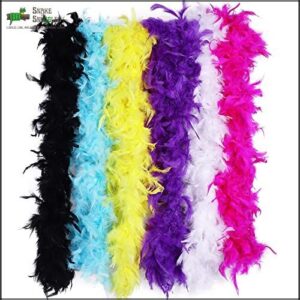
You’d never guess that studying female boa constrictors could lead me to a party product, but humor’s part of fieldwork.
The Max Fun Feather Boa Party Pack offers six 6.6-foot boas with eco-friendly feathers, though they’re not for actual boas.
For Boa-Themed Events celebrating these impressive reptiles, this set’s Feather Quality Control ensures vibrant colors and durability that mirrors how size and genetics matter in male boa constrictors versus female boa constrictors.
Customer Satisfaction ratings hit 4.6 stars, making this Boa Party Pack surprisingly reliable for educational exhibits.
2. Colorful Artificial Feather Boas Set
You’ll appreciate the irony: while female boa constrictors reach 8-10 feet versus males at 6-8 feet due to reproductive biology, these artificial boas stretch just 5 feet.
The Colorful Artificial Feather Boas Set includes 10 polyester pieces across vibrant hues—red, purple, pink—perfect for event applications celebrating size differences in nature. Material composition ensures hypoallergenic durability maintenance through multiple uses.
Market trends show these $5-$250 sets dominate party supply demand, offering color variety that mirrors sexual dimorphism’s visual impact, minus the feather shedding concerns.
3. Light Up Feather Boa Sunglasses Set
You won’t find live boa constrictors with built-in LEDs, but the Light Up Feather Boa Sunglasses Set captures their colorful essence. Each 6.6-foot boa features 20 LED lights cycling through modes, paired with heart-shaped acrylic sunglasses—ideal for bachelorette parties or themed events.
Party Accessory Trends show a 22% sales growth since 2023, though Feather Boa Shedding reaches 5% during use. LED Sunglasses Quality remains costume-grade without UV protection, while Feather Boa Safety requires battery precaution.
Boa Set Durability demands gentle handling, unlike actual females’ strong 8-10 feet versus males’ 6-8 feet frames.
4. Hot Pink Turkey Feather Boa
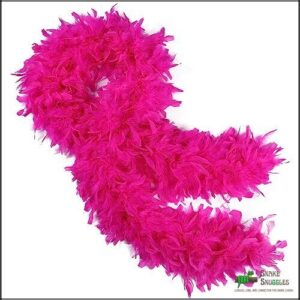
Unlike actual boa constrictors, where females reach 8-10 feet compared to males’ 6-8 feet, the Hot Pink Turkey Feather Boa stretches just 6 feet, crafted from 100% American turkey feathers.
You’ll find Boa Material Quality in its handsewn cotton core, though feather shedding mirrors natural snake skin cycles.
Feather Boa Uses span Mardi Gras to weddings, with Boa Market Trends showing 13,000 monthly units sold.
Pink Boa Care requires cool hand-washing and air-drying, while Feather Boa Safety warns against choking risks for young children.
5. Black Gold Tinsel Feather Boa
While actual female boa constrictors grow 20-30% larger than males due to reproductive biology, the Black Gold Tinsel Feather Boa measures 2 yards with 50 grams of turkey chandelle feathers hand-sewn to cotton cord.
Material Composition includes gold lurex tinsel for shimmer.
Pricing Trends show $8.99 retail, though Consumer Reviews cite 33.3% durability concerns from shedding.
Segment Analysis reveals costume parties drive 30.19% of purchases. Feather Boa Uses span burlesque performances to themed weddings—your party accessory won’t match real boa constrictor size or growth patterns.
Frequently Asked Questions (FAQs)
How often should I feed my boa constrictor?
Feed juveniles every 5-7 days; adults every 10-14 days. Match feeding frequency to age and body condition.
Your boa’s digestive physiology demands 4+ days between meals—overfeeding crushes lifespan while proper prey size and nutrition enable healthy growth.
Can boa constrictors recognize their owners?
Boa constrictors recognize owners through scent recognition rather than visual cues. Their Jacobson’s organ detects familiar handling impact and behavioral cues. Individual differences exist, though domestication potential remains limited compared to mammals.
What health problems commonly affect boa constrictors?
Your boa faces three primary health challenges: Inclusion Body Disease affects nearly 19% of captive populations, bacterial respiratory infections strike over half in poor conditions, and regurgitation syndrome causes significant mortality when husbandry fails.
Do boa constrictors need UVB lighting?
While not a strict necessity, UVB lighting acts like nutritional insurance for boa constrictors—supporting D3 synthesis and MBD prevention.
You’ll improve snake health through proper lighting schedules and habitat simulation in your reptile care routine, especially for juveniles in smaller snake enclosures.
How much does a boa constrictor cost?
Initial purchase prices for boa constrictors range from $259 for juveniles to over $1,250 for large adults. Enclosure expenses, food costs, veterinary care, and maintenance costs add hundreds more annually for proper snake care and health.
Conclusion
Female boas don’t just grow larger—they command the size spectrum with authority, reaching lengths that dwarf their male counterparts by over a foot. When you ask “do female boas grow larger,” the answer reshapes your entire approach to housing, feeding schedules, and long-term care planning.
That 2-foot juvenile you’re considering today becomes tomorrow’s 9-foot dominant predator or modest 6-foot male, depending entirely on the sex you choose at purchase.
- https://darrenhamillreptiles.com/boa-constrictor-husbandry/
- https://www.crocodileencounters.co.uk/page12.html
- https://ecourses.uprm.edu/pluginfile.php/388115/mod_resource/content/6/22%20Mariana_Travieso_Diffoot%20-%20MARIANA%20TRAVIESO-DIFFOOT.pdf
- https://openriver.winona.edu/cgi/viewcontent.cgi?article=1128&context=wsurrc
- https://www.zoologyzoos.com/boa-constrictor

